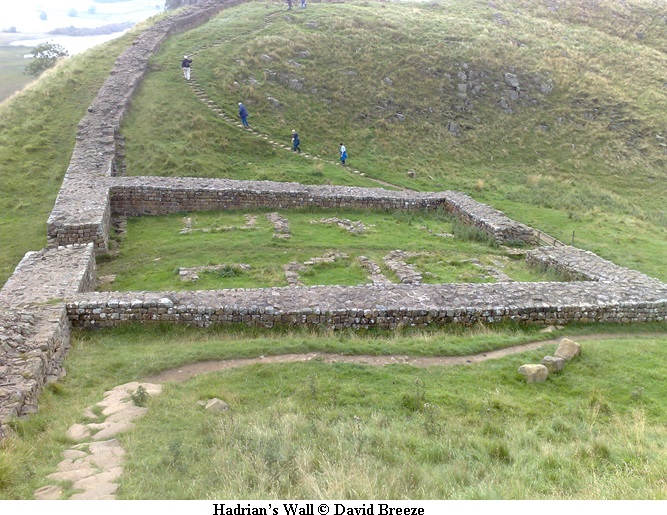

Auditorium, National Museum of Scotland, Edinburgh (Use Lothian Street entrance on Friday, Main entrance Saturday and Sunday)
Professor David Breeze OBE, BA, PhD, Hon DLitt, FSA, Hon FSA Scot, FRSE, Hon CIfA
Hadrian’s Wall: A Study in Archaeological Exploration and Interpretation
Hadrian’s Wall was written about even when it was still in use as a frontier. Interest continued through the next 1000 years, but it was the spirit of enquiry generated by the Renaissance which led to more focussed study. Once archaeological excavations started, the pace quickened. Now we have an enormous data base even though only about 5% of the Wall has been examined. To understand our interpretations of Hadrian’s Wall today, it is necessary to start in the 1840s, and in particular consider the work and influence of John Collingwood Bruce (Rhind lecturer in 1883). The first two lectures in this series of six will review the excavations and surveys, theories and flights of fancy since that decade. The next two lectures concentrate on the different phases of activity on the Wall and through them seek understanding of how the Wall operated. The impact of the Wall on local people and the landscape is the subject of the fifth lecture, while in the final talk the state of Hadrian’s Wall today is considered, with time for questions.
Friday 10th May
6.00 pm Lecture 1. 1848: The Year of Revolutions, on Hadrian’s Wall as well as on the continent
The Wall entered the modern era in 1848. John Hodgson had just persuasively argued that the Wall had indeed been built by Hadrian. John Clayton had undertaken his first excavation on the Wall and discovered a gate through it, thereby challenging existing perceptions of the relationship between Rome and her neighbours. John Collingwood Bruce undertook his tour of the Wall in 1848, led the first Pilgrimage in 1849, and published his first book in 1851,. The position of Bruce as ‘king of the Wall’ was established and he was to remain as such for the next forty years.
Followed by a wine reception
Saturday 11th May
11.00 am Lecture 2. The Twentieth Century: The Age of Archaeology
The year of Bruce’s death in 1892 saw the first excavation of the modern era. Foremost of the excavators were Francis Haverfield, who sought to understand the earthworks comprising the Wall, and J. P. Gibson, who examined its structures. Hadrian’s Wall became the subject of discussion in German as well as British journals. The 1960s saw the advance of the first of a new series of ‘heretical’ views that reached its apogee in the mid-1970s, when those promulgated in Breeze and Dobson’s Hadrian’s Wall became the new ‘paradigm’. Over recent decades, research excavations have been overtaken not only by rescue work but also ‘tourism’ archaeology, now undertaken by commercial units rather than societies or universities.
2.00 pm Lecture 3. The purpose and operation of Hadrian’s Wall under Hadrian
The process of building Hadrian’s Wall with its several layers of changes helps us to understand how it was intended to work. The role of Hadrian in the design and building of his Wall Created a unique monument, moreover, in order to understand this frontier better we must relate it to the way the Roman army operated and fought. Leo Rivet’s ‘evidence by analogy’ will be brought into play so that we can also better understand Hadrian’s Wall through comparison with other Roman and Greek linear barriers.
3.30 pm Lecture 4. The Wall after Hadrian: changing functions?
Did the Wall’s function change over the following centuries – and how can we tell? Changes in the use of its installations – turrets, milecastles and forts – together with military deployment in the north of Britain over a period of three centuries will be examined. The implications of the formation of the late Roman army for Hadrian’s Wall will be considered, together with developments in military architecture in the fourth century. What can these aspects tell us about Rome’s enemies in the north and west, the Picts and Scots? How successful was Hadrian’s Wall?
Sunday 12th May
2.00 pm Lecture 5. The impact of Rome: Life on and around the Wall
As a major statement in the landscape we might expect that it had implications for the local people of the area. Can we recognise these implications? In this lecture, the people of the Wall and the social and economic elements of the Wall will be examined. These aspects include extra-mural settlements outside forts, rural settlements in the Wall corridor, supply and changes over the centuries.
3.30 pm Lecture 6. Hadrian’s Wall today and in the future
An understanding of Hadrian’s Wall has to take into account our own biases as well of those of our forebears and the experiences which led to the development of these views. The importance of maintaining the Wall in its landscape setting is emphasised. The implications of its status as a World Heritage Site and of the creation of the National Trail along its length in 2003 and of tourism generally will be considered against the background of the protection and study of the archaeological resource. Within the framework of modern research strategies, the success of earlier such documents will be reviewed, and the importance of operating within an international framework stressed.
Help us: champion research; stimulate discussion; enhance public understanding; and share our extraordinary heritage. Donate directly to the Society now.